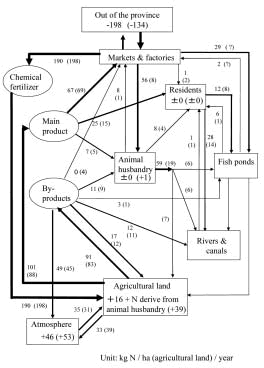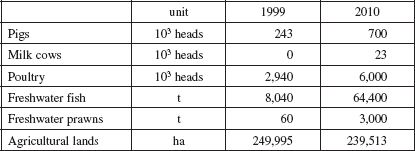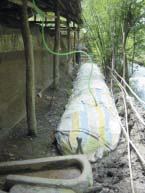Estimation of changes in nitrogen flow accompanying agricultural development in Cantho Province, Vietnam predicted for 2010
Description
[Objectives]
Farming systems in Vietnam's Mekong Delta have been subjected to increased agro-chemical input in order to greatly intensify agricultural activity, and thereby significantly raise profits. As a result, however, material flows of various chemicals, and in particular, nitrogen, have been disturbed, a process that could lead to an increase in water pollution. The goal of this study was to estimate nitrogen flow in 1999 in order to determine how agricultural development will impact nitrogen flow and water pollution through the year 2010 in Cantho Province, Vietnam.
[Results]
Cantho Province lies on the right bank of the Hau River in the central part of the Mekong Delta, and supports a population of more than 1,815,272 over 296,422 ha of land. A model was constructed to calculate nitrogen flow during 1999 and estimate nitrogen flows during 2010. The unit nitrogen flow (kg N/ha/ year) refers to the nitrogen flow (kg N/year) divided by the area of agricultural land or planned agricultural land of Cantho Province in 1999 and 2010, respectively. To determine the volume of nitrogen flows, researchers used the official agricultural development plan authorized by the People's Committee of Cantho Province, entitled "Agricultural Planning for Cantho Province to 2010," in order to provide the predicted figures for agricultural production, cultivated area, livestock, food consumption by residents, and population for the year 2010. Where information was not provided, researchers compensated by using data from related reports published in Japan and other foreign countries.
The estimated nitrogen flow in Cantho Province in 1999 and 2010 is shown in Fig. 1. The plan predicts rapid development in the areas of animal husbandry and aquaculture (Table 1), which will bolster the demand for animal and fish feeds. If the number of livestock increases as reported, livestock excreta per unit area of agricultural land will increase from 19 to 59 kg N/ha/year. Although material cycling in Cantho Province has been intensified with the development of agriculture since the 1980s, the nitrogen balance in the agricultural land was +39 kg N/ha/year in 1999, and it seems that this balance will not change significantly towards 2010. These results indicated that the nitrogen balance will be in relatively good condition through 2010. Therefore, since the agricultural land of Cantho Province still maintains a capacity to absorb nitrogenous wastes from animal husbandry and aquaculture, it is essential that more livestock excreta be applied to agricultural land, rather than be discarded directly into rivers, in order to protect public health and the environment. To this end, the use of biogas digesters (Fig. 2) and the composting of livestock feces should be promoted in this region.
Figure, table
-
Fig. 1. Predicted nitrogen flow in Cantho Province (2010). -
Table 1. Agricultural data for Cantho Province.
-
Fig. 2. Plastic biogas digester.
- Affiliation
-
Japan International Research Center for Agricultural Sciences Crop Production and Environment Division
- Classification
-
Technical B
- Term of research
-
FY2002 (FY1999-2003)
- Responsible researcher
-
WATANABE Takeshi ( Crop Production and Environment Division )
NAGUMO Toshiyuki ( Hokkaido University )
HUNG Ngo Ngoc ( Can Tho University )
- ほか
- Publication, etc.
-
Watanabe, T. (2002): Estimation of nitrogen flow in Cantho province in 2010. Proceedings of the 2002 annual workshop of JIRCAS Mekong Delta Project, 249–257.
- Japanese PDF
-
2002_11_A3_ja.pdf873.28 KB
- English PDF
-
2002_11_A4_en.pdf67.17 KB



